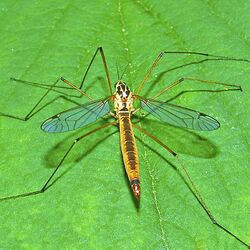Biology:Nephrotoma cornicina
| Nephrotoma cornicina | |
|---|---|

| |
| Nephrotoma cornicina, female with ovipositor | |
| Scientific classification | |
| Domain: | Eukaryota |
| Kingdom: | Animalia |
| Phylum: | Arthropoda |
| Class: | Insecta |
| Order: | Diptera |
| Family: | Tipulidae |
| Genus: | Nephrotoma |
| Species: | N. cornicina
|
| Binomial name | |
| Nephrotoma cornicina | |
| Synonyms | |
| |
Nephrotoma cornicina is a species of fly in the family Tipulidae.[1]
Subspecies
Subspecies include:[2]
- Nephrotoma cornicina cornicina (Linnaeus, 1758)
- Nephrotoma cornicina sardiniensis Oosterbroek, 1978 (Sardinia)
Distribution
This species is widely distributed in the Palearctic realm. It can be found in most of Europe (Albania, Andorra, Austria, Belarus , Belgium, Bosnia-Herzegovina, Bulgaria, Croatia, Czech Republic, Denmark , Estonia, Finland , France , Germany , Great Britain, Greece, Hungary, Ireland, Italy, Latvia, Lithuania, Luxembourg, Malta, Montenegro, Netherlands, North Macedonia, Norway , Poland , Portugal, Romania, Serbia, Slovakia, Slovenia, Spain , Sweden, Switzerland , Ukraine ), in the European Russia, in Kazakhstan, Turkmenistan, Uzbekistan, Tajikistan, Kyrgyzstan, Afghanistan, Mongolia, Japan , China , India , Pakistan , in the Nearctic realm (Canada , United States ), and in the Near East (Georgia, Armenia, Azerbaijan, Turkey, Cyprus, Lebanon, Israel, Iran).[3]
Habitat
These flies mainly inhabit turf grass and hedge rows.[4][5]
Description
Nephrotoma cornicina can reach a body length of 12–15 millimetres (0.47–0.59 in) and a wing length of 11–15 millimetres (0.43–0.59 in).[5] On the wings the stigma is quite small, brown or black, clearly distinct. These flies have slender-bodies, with elongate an rather narrow wings and very long and slender legs. Ocelli are absent and the occipital mark is black. Flagellum is entirely black. Abdomen is mainly yellow, with a dark median stripe, sometimes absent on tergites 6 and 7. In males sternite 8 shows a straight rather long appendage directed at caudal margin. Tergite 9 is short and rather broad, swollen and rounded towards sides. The females have a pointed shiny brown ovipositor with a black basal half, for laying eggs into the ground.[6][7][8][9]
Biology
Adults can be found from late April to mid-September.[4][5] They feed on nectar of Taraxacum campylodes and Anthriscus sylvestris.[5]
References
- ↑ BioLib
- ↑ Catalogue of life
- ↑ Fauna europaea
- ↑ 4.0 4.1 Discover life
- ↑ 5.0 5.1 5.2 5.3 J.K. Lindsey Commanster
- ↑ R.L.Coe, P. Freeman, P.F. Mattingly Handbook for identification of British Insectes
- ↑ Bei-Bienko, G.Y. & Steyskal, G.C. (1988) Keys to the Insects of the European Part of the USSR, Volume V: Diptera and Siphonaptera, Parts I, II . Amerind Publishing Co., New Delhi. ISBN:81-205-0080-6 ISBN:81-205-0081-4
- ↑ Pierre, C., (1924) Diptères : Tipulidae. Paris: Éditions Faune de France 8 159 p. Bibliotheque Virtuelle Numerique pdf
- ↑ Qiu-Lei Men, Guo-Xi Xue, and Hai Yang new species of the genus Nephrotoma (Diptera, Tipuloidea, Tipulidae) from China with a key to species from Mainland China
External links
Wikidata ☰ Q2749789 entry
 |

